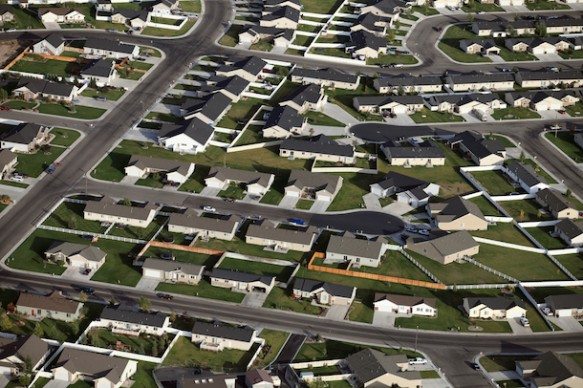9 Ways to Edit Your Life in the Suburbs
It has been rightly pointed out that we at LifeEdited have a heavy urban bias. We sing the praises of compact apartments nestled in vibrant streets where we all frolick, ahem, walk or bike to world class restaurants, charming cafes and green markets; where cars are only used for the rare road trips to bucolic countrysides; where the reusable shopping-bag denizens create a fraction of the carbon footprint of the national norm.
But sometimes we miss the point. Many, many people live in the suburbs–roughly 2/3 of Americans. Many of them happily. They like their lawns, cars and streets that aren’t punctuated by the sound of sirens every five minutes. They don’t mind doing yard work, thank you very much. They accept and occasionally enjoy their commutes to work. And yet, many of these folks (of which you might consider yourself one) want to simplify their lives. They want to have more time, money and peace of mind. They want to reduce the amount of stuff they have and their carbon footprints. They just don’t want to move to the city.
A while back we wrote a popular post entitled “The New American Dream Home,” which profiled the Kawabatas, a family of four living in a not-so-small suburban home. The post was popular, we believe, because it presented a middle ground between extreme minimalist urbanism and unchecked suburban profligacy.
For the record, if you’re going to move, even within the burbs, we suggest finding a house that errs on the smaller side of the national norm and is close to the stuff you do–work, shopping, etc. But given that most of us aren’t going to move any time soon, or not based of some bloggers suggestion, we thought we’d offer a list of things you can do–some simple, some more involved–to create an edited home whilst living in the burbs.
- Get rid of stuff. As the old saying goes, nature abhors a vacuum, and given that suburban homes tend to be on the larger side, resisting the urge to fill your rooms with stuff can be difficult. But living with too much stuff is also difficult. There’s more stuff to buy, maintain, dust, organize, clean and toss. And while ultra-austere environments might not be everyone’s cup of tea, most of us appreciate a clear space more than we suspect. We suggest getting rid of stuff you don’t need, use or want, whether it’s housewares, furniture, clothes or paperwork. Edit ruthlessly. Just because you have the space doesn’t mean you have to fill it.
- Organize. With a bigger house, the tendency for out-of-sight-out-of-mind increases. Work on going through all of your home’s spaces, getting rid of stuff wherever possible, then organizing. Sort through storage areas, digitize paperwork and photos, make sure everything has a proper place. On the other side is the mental liberation that comes when we know what we have and where it’s at.
- Consider going natural. One of the larger time-sinks of having a single-family home is routine lawn care and landscaping. There are many types of beautiful grasses, shrubs and other plant life that need no or minimal upkeep. Look into what those things are for your particular climate and consider them as an alternative to the standard suburban mowed lawn and trimmed hedge aesthetic.
- Think before you drive. It’s sort of an inescapable truth that most suburbs truly depend on the car. Distances between destinations are generally too long for a walk and even a bike in many cases. That said, more and more municipalities are adding bike lanes and paths as well as public transport. While these forms of transit might lack the lightning speed of hopping in your car, there are many ancillary benefits like getting exercise, saving money and cutting your carbon footprint. Consider upgrading your commuter bike and riding that ten mile trip to work. Use the time waiting and riding the bus to catch up on reading.
- Telecommute whenever possible. The average American spends 50 minutes a day on his or her commute. And many people report that their commutes are the low-points of their days. If you have a flexible work situation, regain that time and sanity and consider making a request to work from home, even if only for one day a week.
- Close off a room. I know, this might sound weird, but the fact is many of us have spaces in our homes we simply don’t use enough to justify their upkeep–cleaning, heating and cooling. Consider making the room off limits–shutting the vents, covering the windows, etc–until you have a use for it.
- Get a lodger. This falls a bit outside the suburban norm, but fitting more people into a space cuts down on sprawl, can spread expenses and, assuming you have reasonably good interpersonal skills, might even make your home a more interesting place to live. Don’t want a stranger–consider having a family member moving in. Don’t want a family member–consider a stranger.
- Look into an Accessory Dwelling Unit (ADU). This one is a bit of a radical proposition, but depending on zoning where you live, you might be able to add an additional home to your existing home’s lot. Throw a tiny house in your back yard and rent out your main house–or vice versa.
- Use and love your space. Probably the biggest shame of the big American house is that it doesn’t get used enough. There is no “right size” for a home. If a space is frequently used and enjoyed, then it’s probably the right size. Host parties, BBQ’s, movie nights and other community activities. Size is an asset when it’s used.
Do you live an edited life if the suburbs? What would you add to this list? Let us know in our comments section.
Arial view of housing subdivision image via Shutterstock





